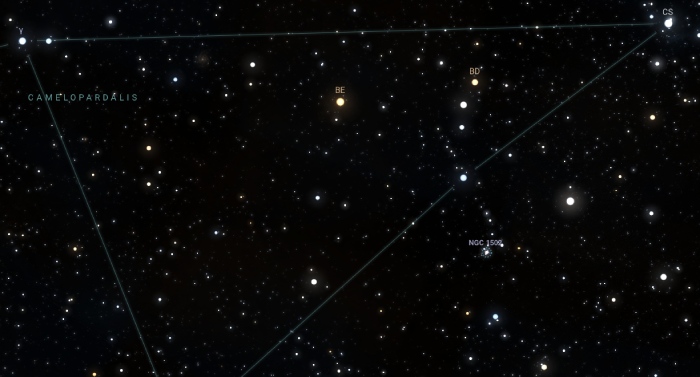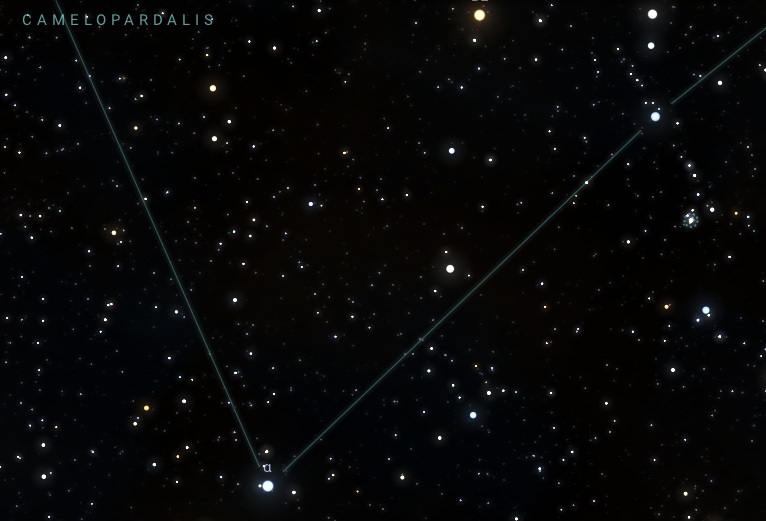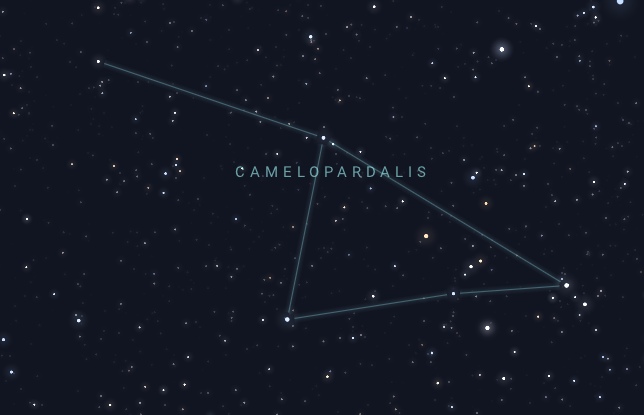Camelopardalis is a large but faint constellation located in the northern celestial hemisphere. Its name derives from the Latin words “camelus” (camel) and “pardalis” (leopard), referring to a mythical creature combining traits of both animals—commonly associated with a giraffe due to its elongated neck and spotted appearance.
Shape
Camelopardalis is a dim constellation, lacking prominent stars, which makes it challenging to locate without assistance. It is bordered by several well-known constellations, including Ursa Major, Ursa Minor, Draco, and Lynx.
Positioned near the north celestial pole, it is circumpolar for observers in the Northern Hemisphere, meaning it remains visible throughout the year. However, its faint stars and diffuse appearance cause it to be frequently overlooked by casual stargazers. For this reason, it is best explored with the aid of star charts or sky-mapping software.
Deep-Sky Objects
Though Camelopardalis lacks bright stars, it compensates with intriguing deep-sky objects. One notable example is the Camelopardalis Dwarf Galaxy, a faint satellite galaxy of the Milky Way located within its boundaries. Part of the Local Group, this small galaxy is less prominent than its larger neighbours, but it provides an interesting target for advanced observation.
Another noteworthy feature is NGC 2403, a spiral galaxy situated about 10 million light-years away, which lies within the constellation. This galaxy, part of the M81 Group, is relatively bright for amateur telescopes and features distinct spiral arms.
Mythology
Unlike many constellations, Camelopardalis does not have significant ties to mythology or ancient legends. Its name is purely descriptive, originating from the Latin words for camel and leopard, reflecting the giraffe-like appearance described by early astronomers. This absence of mythological stories makes it unique among constellations, as it was created relatively late in history by astronomer Petrus Plancius in the 17th century.
Observation
Camelopardalis is not easily seen with the naked eye due to its faint stars and lack of a defined shape. Observing the constellation is most rewarding under dark skies, away from light pollution. Binoculars or small telescopes are essential tools for spotting its subtler features and deep-sky objects.
The best time to observe Camelopardalis in the Northern Hemisphere is during the late winter and early spring months, from February to April. During this period, it can be found high in the northern sky, especially during the late evening and early morning hours. However, its circumpolar nature allows dedicated stargazers in northern latitudes to observe it throughout the year, weather permitting.

Star Magnitudes
Camelopardalis is not known for bright stars, with most of its stellar members having magnitudes too faint to attract widespread attention. Below are some of its more notable stars, along with their magnitudes and distances from Earth:
Beta Camelopardalis – Magnitude: 4.03. Distance: ~1,000 light-years
CS Camelopardalis – Magnitude: 4.21. Distance: ~690 light-years
Alpha Camelopardalis – Magnitude: 4.29. Distance: ~6,000 light-years
13 Camelopardalis – Magnitude: 4.60. Distance: ~360 light-years
These stars, though faint, provide points of interest for those exploring this constellation. Their subtle presence adds to the challenge and satisfaction of observing Camelopardalis, making it a rewarding target for dedicated amateur astronomers.




